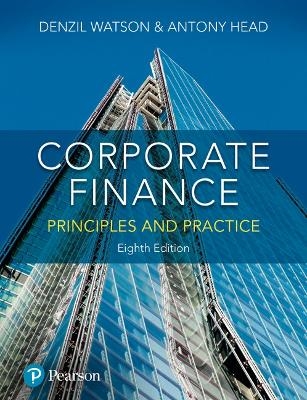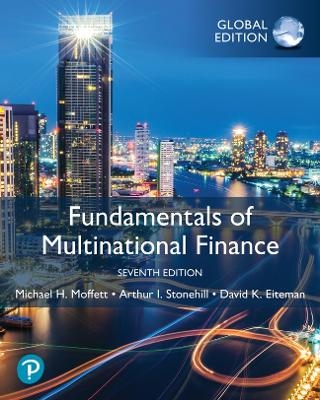
Corporate Finance + MyLab Finance with Pearson eText (Package)
Pearson Education Limited
978-1-292-24440-2 (ISBN)
What’s new?
Chapter vignettes are refreshed and the accompanying questions are updated, with the aim of deepening student's knowledge of key contemporary issues
Up-to-date with the latest changes in regulations and taxation, such as the UK tax treatment of dividends
Denzil Watson is a Principal Lecturer and Antony Head is an Associate Lecturer in the Sheffield Business School at Sheffield Hallam University. They have extensive experience of teaching corporate finance, managerial finance and strategic financial management over many years and in a wide range of courses at undergraduate, postgraduate and professional level.
This package includes MyLab Finance. Students, if MyLab Finance is a recommended/mandatory component of the course, please ask your instructor for the correct ISBN and course ID. MyLab Finance should only be purchased when required by an instructor. Instructors, contact your Pearson representative for more information.
Denzil Watson is a Principal Lecturer, and Antony Head is an Associate Lecturer in the Sheffield Business School at Sheffield Hallam University. They both have extensive experience teaching Corporate Finance, managerial finance, and strategic financial management in a wide range of courses, at undergraduate, postgraduate, and professional levels.
Preface Acknowledgements
The finance function Learning objectives Introduction
1.1 Two key concepts in corporate finance
1.2 The role of the financial manager
1.3 Corporate objectives
1.4 How is shareholder wealth maximised?
1.5 Agency theory
1.6 Corporate governance
1.7 Conclusion
Key points Self-test questions Questions for review Questions for discussion References Recommended reading
Capital markets, market efficiency and ratio analysis Learning objectives Introduction
2.1 Sources of business finance
2.2 Capital markets
2.3 Capital market efficiency
2.4 Assessing financial performance
2.5 Conclusion
Key points Self-test questions Questions for review Questions for discussion References Recommended reading
Short-term finance and working capital management Learning objectives Introduction
3.1 The objectives of working capital management
3.2 Working capital policies
3.3 Working capital and the cash conversion cycle
3.4 Overtrading
3.5 Managing inventory
3.6 Managing cash
3.7 Managing trade receivables
3.8 Conclusion
Key points Self-test questions Questions for review Questions for discussion References Recommended reading
Long-term finance: equity finance Learning objectives Introduction
4.1 Equity finance
4.2 The Stock Exchange
4.3 Rights issues
4.4 Scrip issues, share splits, scrip dividends and share repurchases
4.5 Preference shares
4.6 Conclusion
Key points Self-test questions Questions for review Questions for discussion References Recommended reading
Long-term finance: debt finance, hybrid finance and leasing Learning objectives Introduction
5.1 Bonds, loan notes, loan stock and debentures
5.2 Bank and institutional debt
5.3 International debt finance
5.4 Convertible bonds
5.5 Warrants
5.6 Valuing fixed interest bonds
5.7 Valuing convertible bonds
5.8 Leasing
5.9 Evaluating the financial effects of financing choices
5.10 Conclusion
Key points Self-test questions Questions for review Questions for discussion References Recommended reading
An overview of investment appraisal methods Learning objectives Introduction
6.1 The payback method
6.2 The return on capital employed method
6.3 The net present value method
6.4 The internal rate of return method
6.5 Comparing the NPV and IRR methods
6.6 The profitability index and capital rationing
6.7 The discounted payback method
6.8 Conclusion
Key points Self-test questions Questions for review Questions for discussion References Recommended reading
Investment appraisal: applications and risk Learning objectives Introduction
7.1 Relevant project cash flows
7.2 Taxation and capital investment decisions
7.3 Inflation and capital investment decisions
7.4 Investment appraisal and risk
7.5 Appraisal of foreign direct investment
7.6 Empirical investigations of investment appraisal
7.7 Conclusion
Key points Self-test questions Questions for review Questions for discussion References Recommended reading
Portfolio theory and the capital asset pricing model Learning objectives Introduction
8.1 The measurement of risk
8.2 The concept of diversification
8.3 Investor attitudes to risk
8.4 Markowitz's portfolio theory
8.5 Introduction to the capital asset pricing model
8.6 Using the CAPM to value shares
8.7 Empirical tests of the CAPM
8.8 Conclusion
Key points Self-test questions Questions for review Questions for discussion References Recommended reading
The cost of capital and capital structure Learning objectives Introduction
9.1 Calculating the cost of individual sources of finance
9.2 Calculating the weighted average cost of capital
9.3 Average and marginal cost of capital
9.4 The CAPM and investment appraisal
9.5 Practical problems with calculating WACC
9.6 WACC in the real world
9.7 The cost of capital for foreign direct investment
9.8 Gearing: its measurement and significance
9.9 The concept of an optimal capital structure
9.10 The traditional approach to capital structure
9.11 Miller and Modigliani (I): net income approach
9.12 Miller and Modigliani (II): corporate tax
9.13 Market imperfections
9.14 Miller and personal taxation
9.15 Pecking order theory
9.16 Conclusion: does an optimal capital structure exist?
Key points Self-test questions Questions for review Questions for discussion References Recommended reading
Dividend policy Learning objectives Introduction
10.1 Dividends: operational and practical issues
10.2 The effect of dividends on shareholder wealth
10.3 Dividend irrelevance
10.4 Dividend relevance
10.5 Dividend relevance or irrelevance?
10.6 Dividend policies
10.7 Alternatives to cash dividends
10.8 Empirical evidence on dividend policy
10.9 Conclusion
Key points Self-test questions Questions for review Questions for discussion References Recommended reading
Mergers and takeovers Learning objectives Introduction
11.1 The terminology of mergers and takeovers
11.2 Justifications for acquisitions
11.3 Trends in takeover activity
11.4 Target company valuation
11.5 The financing of acquisitions
11.6 Strategic and tactical issues
11.7 Divestment
11.8 Private equity
11.9 Empirical research on acquisitions
11.10 Conclusion
Key points Self-test questions Questions for review Questions for discussion References Recommended reading
Risk management Learning objectives Introduction
12.1 Interest and exchange rate risk
12.2 Internal risk management
12.3 External risk management
12.4 Futures contracts
12.5 Options
12.6 Swaps
12.7 Issues in interest and exchange risk management
12.8 Political risk
12.9 Conclusion
Key points Self-test questions Questions for review Questions for discussion References Recommended reading
Answers to self-test questions Glossary Present value tables Index
| Erscheint lt. Verlag | 22.3.2019 |
|---|---|
| Verlagsort | Harlow |
| Sprache | englisch |
| Maße | 190 x 245 mm |
| Gewicht | 879 g |
| Themenwelt | Wirtschaft ► Betriebswirtschaft / Management ► Finanzierung |
| Wirtschaft ► Betriebswirtschaft / Management ► Rechnungswesen / Bilanzen | |
| ISBN-10 | 1-292-24440-2 / 1292244402 |
| ISBN-13 | 978-1-292-24440-2 / 9781292244402 |
| Zustand | Neuware |
| Haben Sie eine Frage zum Produkt? |
aus dem Bereich


